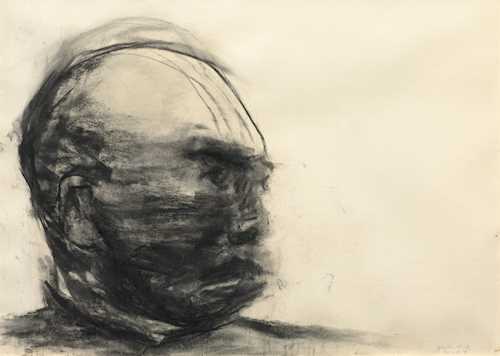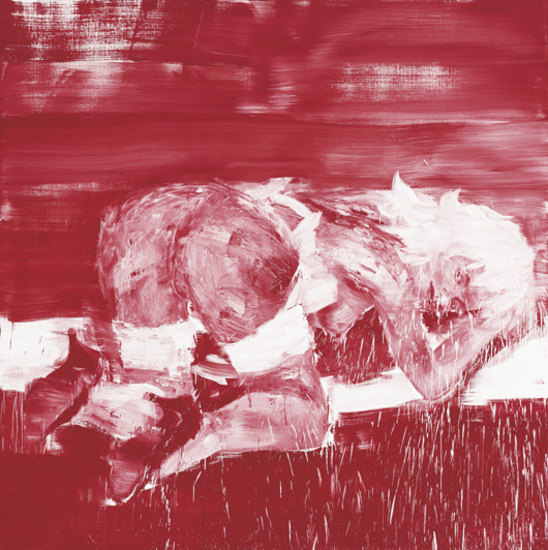Yan Pei-Ming Golden Buddha 2005 oil on canvas 149.9 x 149.9 cm. (59 x 59 in.) Signed, titled and dated 'Yan Pei-Ming "Golden Buddha" 09.2005' on the reverse.
Provenance Massimo de Carlo, Milan Video Yan Pei-Ming 'Golden Buddha', 2005 and 'Double (Artist's Father)', 2007 "I don’t want my paintings to speak in Chinese. My work is not 'made in China' and I don’t want it to speak that language. My paintings don’t need explanation. They just communicate; there is universality to them." - Yan Pei-Ming Peter Sumner, director and head of Contemporary Art in London presents two works from the Contemporary Art Evening and Day Sales by Yan Pei-Ming -- 'Golden Buddha', 2005 and 'Double (Artist's Father)', 2007. A modern day ‘master of brushwork’, Yan Pei-Ming has become one of China’s leading painters, creating signature works that are instantly recognizable for their dramatic strokes and monochromatic tones. The artist represents a unique bridge between Eastern and Western cultures by producing a body of work that aligns in a classically ‘Western’ genre of portraiture yet doing so within a Chinese aesthetic. Catalogue Essay “I don’t want my paintings to speak in Chinese. My work is not “made in China” and I don’t want it to speak that language. My paintings don’t need explanation. They just communicate; there is universality to them.” YAN PEI-MING A modern day ‘master of brushwork’, Yan Pei-Ming has become one of China’s leading painters, creating signature works that are instantly recognizable for their dramatic strokes and monochromatic tones. The artist represents a unique bridge between Eastern and Western cultures by producing a body of work that aligns in a classically ‘Western’ genre of portraiture yet doing so within a Chinese aesthetic. This truly parallels with his path as an artist. Growing up in Shanghai during China’s Cultural Revolution, Yan moved to France in 1980 at the age of 19 to pursue his artistic interests, a career that could not have been viable in China due to the vast limitations posed by his family’s status. Much in the same vein as his Western predecessor, Andy Warhol Yan Pei-Ming is notably celebrated for electrifying large-scale renditions of iconic figures such as Mao Zedong and Buddha, rendered in expressive bursts of rapid brushstrokes. Indeed, the artist’s distinctive methodology in painting takes on a gestural approach which is reminiscent of Western Abstract expressionist artists such as De Kooning and Pollock, where they confront the canvas and attack it aggressively with paint. The artist adopts abnormally large brushes, ranging from 20 to 50 inches in width, using them to create powerful yet fluid brushstrokes, a technique that aligns with traditional Zen Buddhist painters and calligraphers, who deliberately use large tools to liberate themselves creatively and let go of their conscious impulses. In the present lot, Golden Buddha, 2005, Yan’s subject matter takes on a photographic quality, demonstrating his ability to juxtapose realism and the transcendent through a modestly descriptive use of paint. The figure within the canvas is emphasized by the monochromatic background and the variation of brushstrokes. As expressed by the artist: “I have never felt it necessary to put some things around the persons; I just want to draw portraits.” (Yan Pei Ming, in the synopsis for his 2009 exhibition at the Ullens Centre for Contemporary Art, Landscape of Childhood). Distinguished by an extremely restricted palette, usually ranging between variations of black, Yan utilizes minimalism to express emotions in a personal and direct manner. The present lot, however, is an exciting and mesmerizing departure from his usual palette, radiating with tones of gold and accents of white that illuminate Buddha in all his splendour. Golden Buddha is a quintessential work by Yan which expresses his capabilities of fusing two worlds by turning a classic Buddhist icon into a Western art practice, executing it in a way that abstracts the subject matter into something even more symbolic. As with his portraits of Mao Zedong, viewed at close proximity Golden Buddha may appear to have
Yan Pei-Ming Golden Buddha 2005 oil on canvas 149.9 x 149.9 cm. (59 x 59 in.) Signed, titled and dated 'Yan Pei-Ming "Golden Buddha" 09.2005' on the reverse.
Provenance Massimo de Carlo, Milan Video Yan Pei-Ming 'Golden Buddha', 2005 and 'Double (Artist's Father)', 2007 "I don’t want my paintings to speak in Chinese. My work is not 'made in China' and I don’t want it to speak that language. My paintings don’t need explanation. They just communicate; there is universality to them." - Yan Pei-Ming Peter Sumner, director and head of Contemporary Art in London presents two works from the Contemporary Art Evening and Day Sales by Yan Pei-Ming -- 'Golden Buddha', 2005 and 'Double (Artist's Father)', 2007. A modern day ‘master of brushwork’, Yan Pei-Ming has become one of China’s leading painters, creating signature works that are instantly recognizable for their dramatic strokes and monochromatic tones. The artist represents a unique bridge between Eastern and Western cultures by producing a body of work that aligns in a classically ‘Western’ genre of portraiture yet doing so within a Chinese aesthetic. Catalogue Essay “I don’t want my paintings to speak in Chinese. My work is not “made in China” and I don’t want it to speak that language. My paintings don’t need explanation. They just communicate; there is universality to them.” YAN PEI-MING A modern day ‘master of brushwork’, Yan Pei-Ming has become one of China’s leading painters, creating signature works that are instantly recognizable for their dramatic strokes and monochromatic tones. The artist represents a unique bridge between Eastern and Western cultures by producing a body of work that aligns in a classically ‘Western’ genre of portraiture yet doing so within a Chinese aesthetic. This truly parallels with his path as an artist. Growing up in Shanghai during China’s Cultural Revolution, Yan moved to France in 1980 at the age of 19 to pursue his artistic interests, a career that could not have been viable in China due to the vast limitations posed by his family’s status. Much in the same vein as his Western predecessor, Andy Warhol Yan Pei-Ming is notably celebrated for electrifying large-scale renditions of iconic figures such as Mao Zedong and Buddha, rendered in expressive bursts of rapid brushstrokes. Indeed, the artist’s distinctive methodology in painting takes on a gestural approach which is reminiscent of Western Abstract expressionist artists such as De Kooning and Pollock, where they confront the canvas and attack it aggressively with paint. The artist adopts abnormally large brushes, ranging from 20 to 50 inches in width, using them to create powerful yet fluid brushstrokes, a technique that aligns with traditional Zen Buddhist painters and calligraphers, who deliberately use large tools to liberate themselves creatively and let go of their conscious impulses. In the present lot, Golden Buddha, 2005, Yan’s subject matter takes on a photographic quality, demonstrating his ability to juxtapose realism and the transcendent through a modestly descriptive use of paint. The figure within the canvas is emphasized by the monochromatic background and the variation of brushstrokes. As expressed by the artist: “I have never felt it necessary to put some things around the persons; I just want to draw portraits.” (Yan Pei Ming, in the synopsis for his 2009 exhibition at the Ullens Centre for Contemporary Art, Landscape of Childhood). Distinguished by an extremely restricted palette, usually ranging between variations of black, Yan utilizes minimalism to express emotions in a personal and direct manner. The present lot, however, is an exciting and mesmerizing departure from his usual palette, radiating with tones of gold and accents of white that illuminate Buddha in all his splendour. Golden Buddha is a quintessential work by Yan which expresses his capabilities of fusing two worlds by turning a classic Buddhist icon into a Western art practice, executing it in a way that abstracts the subject matter into something even more symbolic. As with his portraits of Mao Zedong, viewed at close proximity Golden Buddha may appear to have





.jpg)






Testen Sie LotSearch und seine Premium-Features 7 Tage - ohne Kosten!
Lassen Sie sich automatisch über neue Objekte in kommenden Auktionen benachrichtigen.
Suchauftrag anlegen